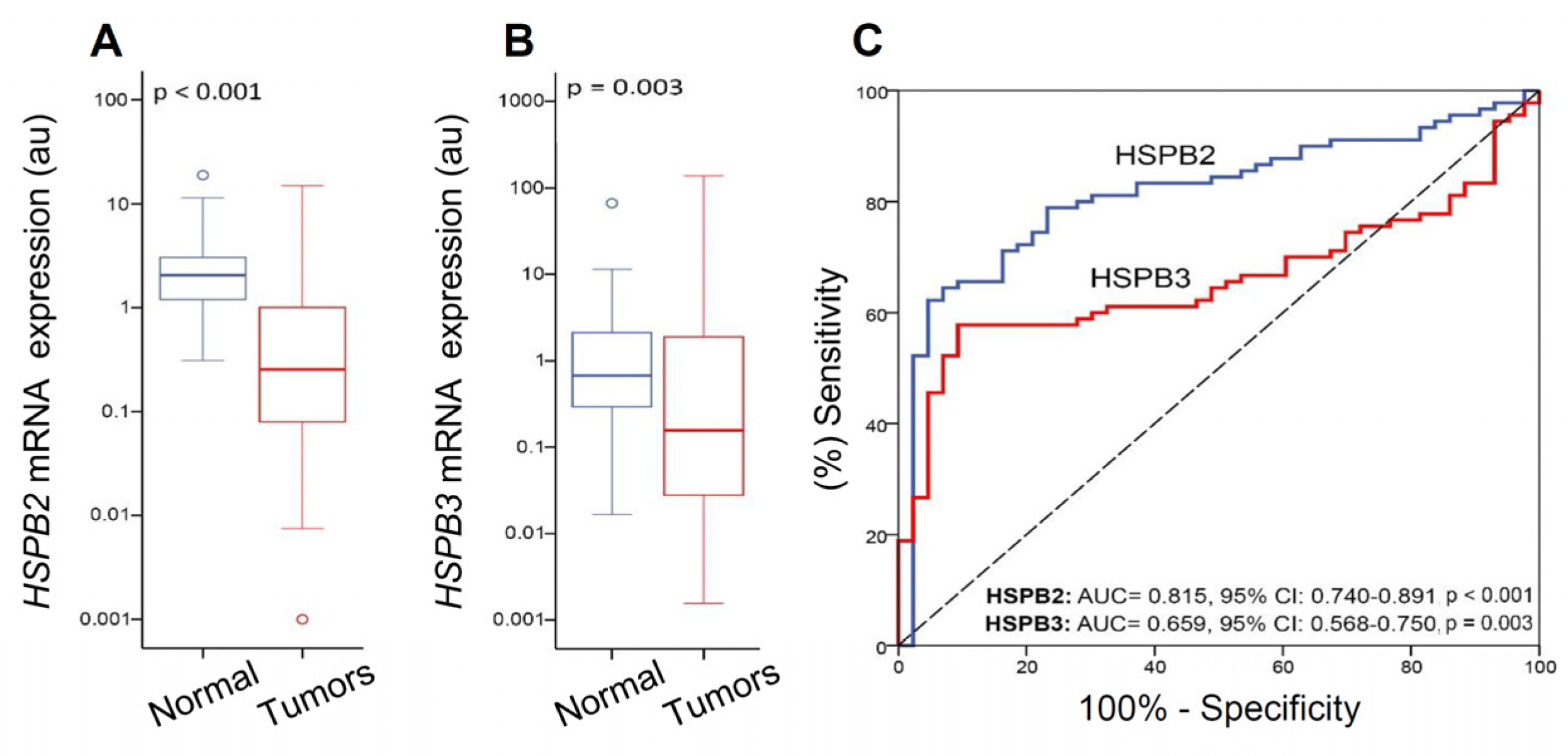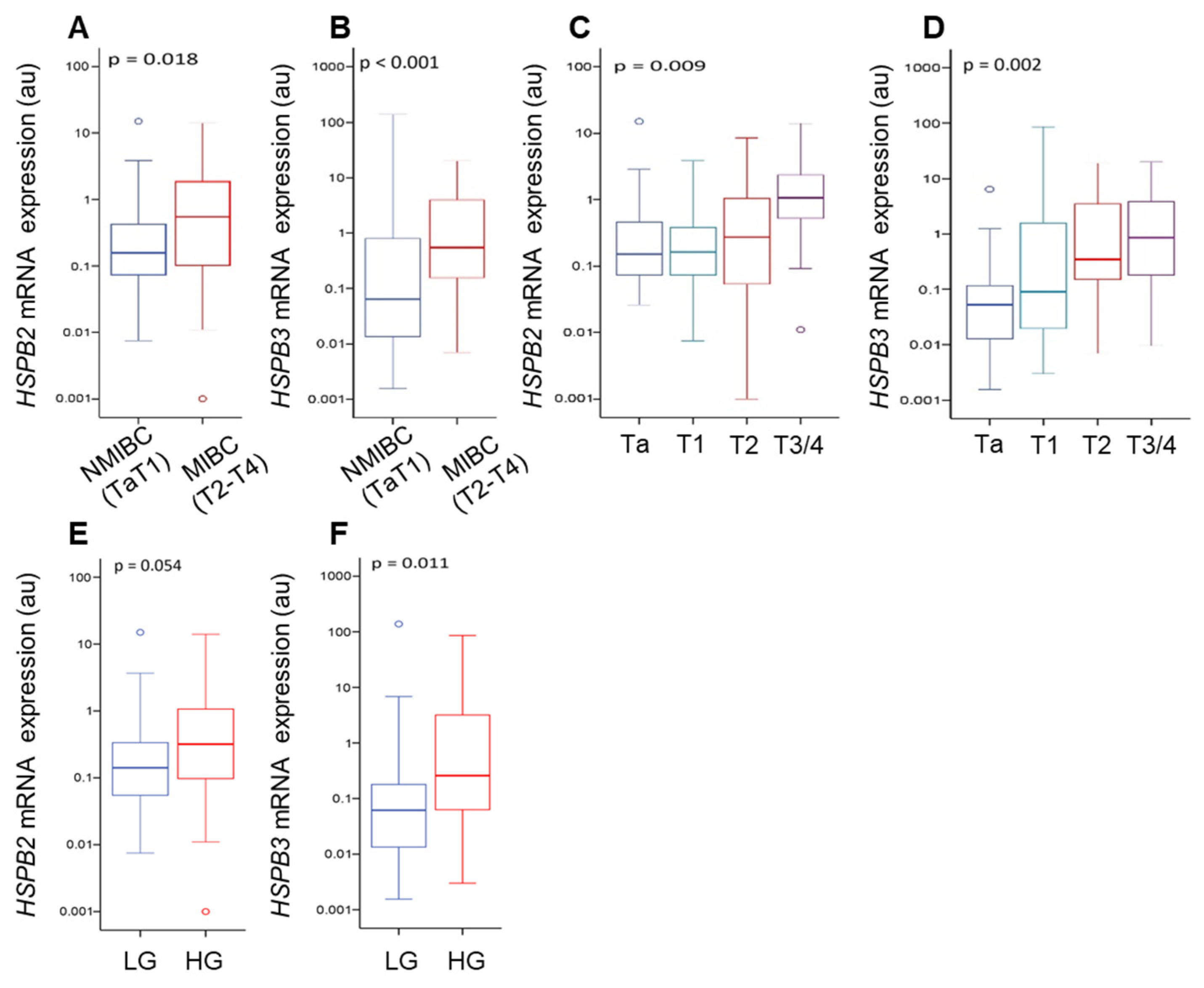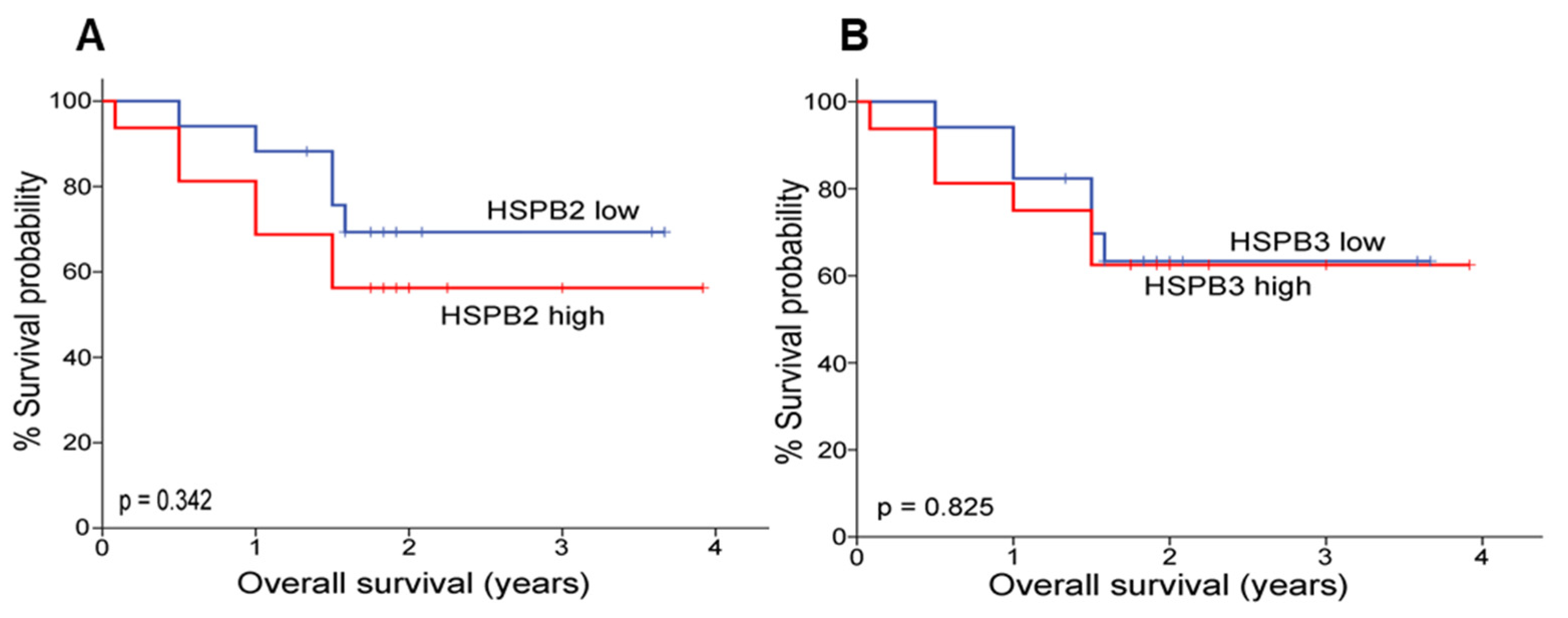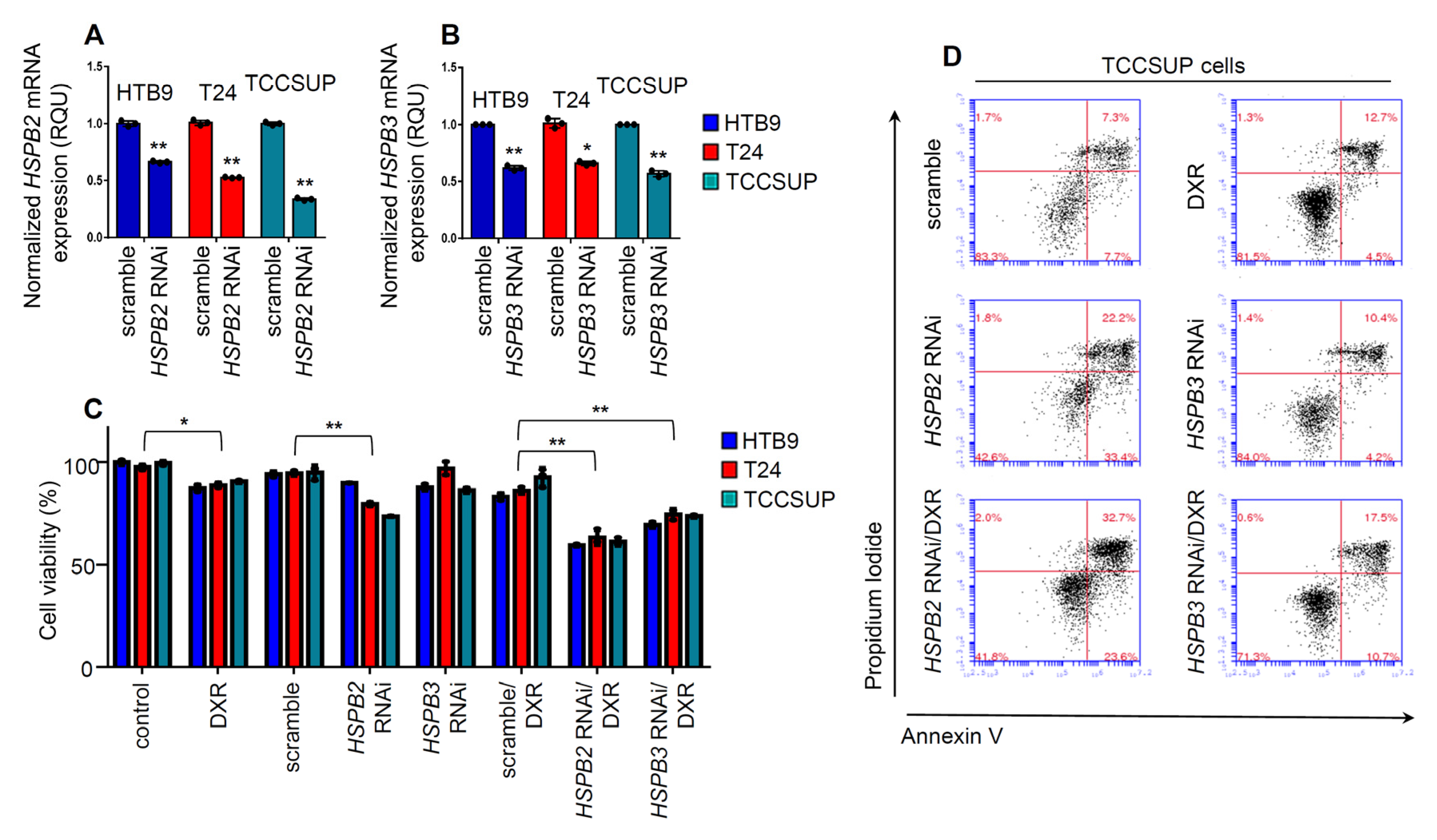Evaluation of the Small Heat Shock Protein Family Members HSPB2 and HSPB3 in Bladder Cancer Prognosis and Progression
Abstract
:1. Introduction
2. Results
2.1. Upregulation of HSPB2 and HSPB3 Gene Expression Levels in Human BlCa Cell Lines
2.2. Baseline Clinical Data
2.3. Reduced Expression Levels of the HSPB2 and HSPB3 mRNA in Bladder Tumors Compared with Paired Non-Cancerous Tissues
2.4. HSPB2 and HSPB3 mRNA Expression Levels Are Related to Unfavorable Prognostic Features of BlCa
2.5. Low Expression Levels of HSPB2 and HSPB3 mRNA Are Correlated with Higher Risk for NMIBC (TaT1) Patients’ Short-Term Relapse
2.6. HSPB2 and HSPB3 Knockdown Decreases Cell Viability and Enhances Chemosensitivity in Human Bladder Cancer Cells
3. Discussion
4. Materials and Methods
4.1. Cell Lines and Cell Culture Conditions
4.2. siRNA Transfection
4.3. Cell Survival Assay
4.4. Apoptosis Assay
4.5. Patients Cohort
4.6. Total RNA Extraction
4.7. First-Strand cDNA Synthesis
4.8. Quantitative Real-Time Polymerase Chain Reaction
4.9. Immunoblotting Analysis
4.10. Statistical Analysis
5. Conclusions
Supplementary Materials
Author Contributions
Funding
Institutional Review Board Statement
Informed Consent Statement
Data Availability Statement
Acknowledgments
Conflicts of Interest
References
- Antoni, S.; Ferlay, J.; Soerjomataram, I.; Znaor, A.; Jemal, A.; Bray, F. Bladder Cancer Incidence and Mortality: A Global Overview and Recent Trends. Eur. Urol. 2017, 71, 96–108. [Google Scholar] [CrossRef] [PubMed]
- Chen, K.; Xing, J.; Yu, W.; Xia, Y.; Zhang, Y.; Cheng, F.; Rao, T. Identification and Validation of Hub Genes Associated with Bladder Cancer by Integrated Bioinformatics and Experimental Assays. Front. Oncol. 2021, 11, 782981. [Google Scholar] [CrossRef] [PubMed]
- Bray, F.; Ferlay, J.; Soerjomataram, I.; Siegel, R.L.; Torre, L.A.; Jemal, A. Global cancer statistics 2018: GLOBOCAN estimates of incidence and mortality worldwide for 36 cancers in 185 countries. CA Cancer J. Clin. 2020, 70, 313. [Google Scholar] [CrossRef] [PubMed] [Green Version]
- Tokas, T.; Avgeris, M.; Alamanis, C.; Scorilas, A.; Stravodimos, K.G.; Constantinides, C.A. Downregulated KLK13 expression in bladder cancer highlights tumor aggressiveness and unfavorable patients’ prognosis. J. Cancer Res. Clin. Oncol. 2017, 143, 521–532. [Google Scholar] [CrossRef]
- Sanli, O.; Dobruch, J.; Knowles, M.A.; Burger, M.; Alemozaffar, M.; Nielsen, M.E.; Lotan, Y. Bladder cancer. Nat. Rev. Dis. Primers 2017, 3, 17022. [Google Scholar] [CrossRef] [Green Version]
- Zang, Y.; Li, X.; Cheng, Y.; Qi, F.; Yang, N. An overview of patients with urothelial bladder cancer over the past two decades: A Surveillance, Epidemiology, and End Results (SEER) study. Ann. Transl. Med. 2020, 8, 1587. [Google Scholar] [CrossRef]
- DeSantis, C.E.; Lin, C.C.; Mariotto, A.B.; Siegel, R.L.; Stein, K.D.; Kramer, J.L.; Alteri, R.; Robbins, A.S.; Jemal, A. Cancer treatment and survivorship statistics. CA Cancer J. Clin. 2014, 64, 252–271. [Google Scholar] [CrossRef]
- Feber, A.; Dhami, P.; Dong, L.; de Winter, P.; Tan, W.S.; Martínez-Fernández, M.; Paul, D.S.; Hynes-Allen, A.; Rezaee, S.; Gurung, P.; et al. UroMark-a urinary biomarker assay for the detection of bladder cancer. Clin. Epigenetics 2017, 9, 8. [Google Scholar] [CrossRef] [Green Version]
- Svatek, R.S.; Hollenbeck, B.K.; Holmäng, S.; Lee, R.; Kim, S.P.; Stenzl, A.; Lotan, Y. The economics of bladder cancer: Costs and considerations of caring for this disease. Eur. Urol. 2014, 66, 253–262. [Google Scholar] [CrossRef]
- Kappé, G.; Franck, E.; Verschuure, P.; Boelens, W.C.; Leunissen, J.A.; de Jong, W.W. The human genome encodes 10 alpha-crystallin-related small heat shock proteins: HspB1-10. Cell Stress Chaperones 2003, 8, 53–61. [Google Scholar] [CrossRef]
- Tedesco, B.; Cristofani, R.; Ferrari, V.; Cozzi, M.; Rusmini, P.; Casarotto, E.; Chierichetti, M.; Mina, F.; Galbiati, M.; Piccolella, M.; et al. Insights on Human Small Heat Shock Proteins and Their Alterations in Diseases. Front Mol Biosci. 2022, 9, 2149. [Google Scholar] [CrossRef] [PubMed]
- Niforou, K.; Cheimonidou, C.; Trougakos, I.P. Molecular chaperones and proteostasis regulation during redox imbalance. Redox Biol. 2014, 2, 323–332. [Google Scholar] [CrossRef] [PubMed] [Green Version]
- Sklirou, A.; Papanagnou, E.D.; Fokialakis, N.; Trougakos, I.P. Cancer Chemoprevention via Activation of Proteostatic Modules. Cancer Lett 2018, 413, 110–121. [Google Scholar] [CrossRef]
- Das, J.K.; Xiong, X.; Ren, X.; Yang, J.M.; Song, J. Heat Shock Proteins in Cancer Immunotherapy. J. Oncol. 2019, 2019, 3267207. [Google Scholar] [CrossRef] [Green Version]
- Ciocca, D.R.; Calderwood, S.K. Heat shock proteins in cancer: Diagnostic, prognostic, predictive, and treatment implications. Cell Stress Chaperones 2005, 10, 6–103. [Google Scholar] [CrossRef] [PubMed]
- Yang, S.; Xiao, H.; Cao, L. Recent advances in heat shock proteins in cancer diagnosis, prognosis, metabolism and treatment. Biomed. Pharmacother. 2021, 142, 112074. [Google Scholar] [CrossRef]
- Conroy, S.E.; Sasieni, P.D.; Amin, V.; Wang, D.Y.; Smith, P.; Fentiman, I.S.; Latchman, D.S. Antibodies to heat-shock protein 27 are associated with improved survival in patients with breast cancer. Br. J. Cancer 1998, 77, 1875–1879. [Google Scholar] [CrossRef] [Green Version]
- Yu, Z.; Zhi, J.; Peng, X.; Zhong, X.; Xu, A. Clinical significance of HSP27 expression in colorectal cancer. Mol. Med. Rep. 2010, 3, 953–958. [Google Scholar] [CrossRef]
- Zhang, Y.; Tao, X.; Jin, G.; Jin, H.; Wang, N.; Hu, F.; Luo, Q.; Shu, H.; Zhao, F.; Yao, M.; et al. A Targetable Molecular Chaperone Hsp27 Confers Aggressiveness in Hepatocellular Carcinoma. Theranostics 2016, 6, 558–570. [Google Scholar] [CrossRef] [Green Version]
- Lee, M.S.; Lee, J.; Lee, S.; Yoo, S.M.; Kim, J.H.; Kim, W.T.; Kim, W.J.; Park, J. Clinical, prognostic, and therapeutic significance of heat shock protein 27 in bladder cancer. Oncotarget 2018, 9, 7961–7974. [Google Scholar] [CrossRef]
- Kamada, M.; So, A.; Muramaki, M.; Rocchi, P.; Beraldi, E.; Gleave, M. Hsp27 knockdown using nucleotide-based therapies inhibit tumor growth and enhance chemotherapy in human bladder cancer cells. Mol. Cancer Ther. 2007, 6, 299–308. [Google Scholar] [CrossRef] [PubMed] [Green Version]
- Iwaki, A.; Nagano, T.; Nakagawa, M.; Iwaki, T.; Fukumaki, Y. Identification and characterization of the gene encoding a new member of the alpha-crystallin/small hsp family, closely linked to the alphaB-crystallin gene in a head-to-head manner. Genomics. 1997, 45, 386–394. [Google Scholar] [CrossRef] [PubMed]
- Yu, Z.; Wang, H.; Fang, Y.; Lu, L.; Li, M.; Yan, B.; Nie, Y.; Teng, C. Molecular chaperone HspB2 inhibited pancreatic cancer cell proliferation via activating p53 downstream gene RPRM, BAI1, and TSAP6. J. Cell Biochem. 2020, 121, 2318–2329. [Google Scholar] [CrossRef] [PubMed]
- Hu, Z.; Yang, B.; Lu, W.; Zhou, W.; Zeng, L.; Li, T.; Wang, X. HSPB2/MKBP, a novel and unique member of the small heat-shock protein family. J. Neurosci. Res. 2008, 86, 2125–2133. [Google Scholar] [CrossRef] [PubMed]
- Boelens, W.C. Structural aspects of the human small heat shock proteins related to their functional activities. Cell Stress Chaperones 2020, 25, 581–591. [Google Scholar] [CrossRef] [Green Version]
- Sugiyama, Y.; Suzuki, A.; Kishikawa, M.; Akutsu, R.; Hirose, T.; Waye, M.M.; Tsui, S.K.; Yoshida, S.; Ohno, S. Muscle develops a specific form of small heat shock protein complex composed of MKBP/HSPB2 and HSPB3 during myogenic differentiation. J. Biol. Chem. 2000, 275, 1095–1104. [Google Scholar] [CrossRef] [Green Version]
- Morelli, F.F.; Verbeek, D.S.; Bertacchini, J.; Vinet, J.; Mediani, L.; Marmiroli, S.; Cenacchi, G.; Nasi, M.; De Biasi, S.; Brunsting, J.F.; et al. Aberrant Compartment Formation by HSPB2 Mislocalizes Lamin A and Compromises Nuclear Integrity and Function. Cell Rep. 2017, 20, 2100–2115. [Google Scholar] [CrossRef] [Green Version]
- Xiong, J.; Li, Y.; Tan, X.; Fu, L. Small Heat Shock Proteins in Cancers: Functions and Therapeutic Potential for Cancer Therapy. Int. J. Mol. Sci. 2020, 21, 6611. [Google Scholar] [CrossRef]
- Kolb, S.J.; Snyder, P.J.; Poi, E.J.; Renard, E.A.; Bartlett, A.; Gu, S.; Sutton, S.; Arnold, W.D.; Freimer, M.L.; Lawson, V.H.; et al. Mutant small heat shock protein B3 causes motor neuropathy: Utility of a candidate gene approach. Neurology 2010, 74, 502–506. [Google Scholar] [CrossRef]
- Vendredy, L.; Adriaenssens, E.; Timmerman, V. Small heat shock proteins in neurodegenerative diseases. Cell Stress Chaperones 2020, 25, 679–699. [Google Scholar] [CrossRef]
- Ischia, J.; So, A.I. The role of heat shock proteins in bladder cancer. Nat. Rev. Urol. 2013, 10, 386–395. [Google Scholar] [CrossRef] [PubMed]
- Yun, C.W.; Kim, H.J.; Lim, J.H.; Lee, S.H. Heat Shock Proteins: Agents of Cancer Development and Therapeutic Targets in Anti-Cancer Therapy. Cells 2019, 9, 60. [Google Scholar] [CrossRef] [PubMed] [Green Version]
- Kalioraki, M.A.; Artemaki, P.I.; Sklirou, A.D.; Kontos, C.K.; Adamopoulos, P.G.; Papadopoulos, I.N.; Trougakos, I.P.; Scorilas, A. Heat shock protein beta 3 (HSPB3) is an unfavorable molecular biomarker in colorectal adenocarcinoma. Mol. Carcinog. 2020, 59, 116–125. [Google Scholar] [CrossRef] [PubMed]
- Artemaki, P.I.; Sklirou, A.D.; Kontos, C.K.; Liosi, A.A.; Gianniou, D.D.; Papadopoulos, I.N.; Trougakos, I.P.; Scorilas, A. High clusterin (CLU) mRNA expression levels in tumors of colorectal cancer patients predict a poor prognostic outcome. Clin. Biochem. 2020, 75, 62–69. [Google Scholar] [CrossRef]
- Alfred Witjes, J.; Lebret, T.; Compérat, E.M.; Cowan, N.C.; de Santis, M.; Bruins, H.M.; Hernández, V.; Espinós, E.L.; Dunn, J.; Rouanne, M.; et al. Updated 2016 EAU Guidelines on Muscle-invasive and Metastatic Bladder Cancer. Eur. Urol. 2017, 71, 462–475. [Google Scholar] [CrossRef] [PubMed]
- Babjuk, M.; Böhle, A.; Burger, M.; Capoun, O.; Cohen, D.; Compérat, E.M.; Hernández, V.; Kaasinen, E.; Palou, J.; Rouprêt, M.; et al. EAU Guidelines on Non-Muscle-invasive Urothelial Carcinoma of the Bladder: Update 2016. Eur. Urol. 2017, 71, 447–461. [Google Scholar] [CrossRef]
- Sylvester, R.J.; van der Meijden, A.P.; Oosterlinck, W.; Witjes, J.A.; Bouffioux, C.; Denis, L.; Newling, D.W.; Kurth, K. Predicting recurrence and progression in individual patients with stage Ta T1 bladder cancer using EORTC risk tables: A combined analysis of 2596 patients from seven EORTC trials. Eur. Urol. 2006, 49, 466–477. [Google Scholar] [CrossRef]
- McConkey, D.J.; Choi, W. Molecular Subtypes of Bladder Cancer. Curr. Oncol. Rep. 2018, 20, 77. [Google Scholar] [CrossRef]
- Lebret, T.; Watson, R.W.; Molinié, V.; Poulain, J.E.; O’Neill, A.; Fitzpatrick, J.M.; Botto, H. HSP90 expression: A new predictive factor for BCG response in stage Ta-T1 grade 3 bladder tumours. Eur. Urol. 2007, 51, 161–167. [Google Scholar] [CrossRef]
- Meeks, J.J.; Al-Ahmadie, H.; Faltas, B.M.; Taylor, J.A., 3rd; Flaig, T.W.; DeGraff, D.J.; Christensen, E.; Woolbright, B.L.; McConkey, D.J.; Dyrskjøt, L. Genomic heterogeneity in bladder cancer: Challenges and possible solutions to improve outcomes. Nat. Rev. Urol. 2020, 17, 259–270. [Google Scholar] [CrossRef]
- Liu, J.; Luo, Z.; Zhang, L.; Wang, L.; Nie, Q.; Wang, Z.F.; Huang, Z.; Hu, X.; Gong, L.; Arrigo, A.P.; et al. The small heat shock protein αA-crystallin negatively regulates pancreatic tumorigenesis. Oncotarget 2016, 7, 65808–65824. [Google Scholar] [CrossRef] [PubMed] [Green Version]
- Sheng, B.; Qi, C.; Liu, B.; Lin, Y.; Fu, T.; Zeng, Q. Increased HSP27 correlates with malignant biological behavior of non-small cell lung cancer and predicts patient’s survival. Sci. Rep. 2017, 7, 13807. [Google Scholar] [CrossRef] [PubMed] [Green Version]
- Wu, J.; Liu, T.; Rios, Z.; Mei, Q.; Lin, X.; Cao, S. Heat Shock Proteins and Cancer. Trends Pharmacol. Sci. 2017, 38, 226–256. [Google Scholar] [CrossRef] [PubMed]
- Albakova, Z.Q.; Norinho, D.D.; Mangasarova, Y.; Sapozhnikov, A. Heat Shock Proteins in Urine as Cancer Biomarkers. Front. Med. 2021, 8, 743476. [Google Scholar] [CrossRef]
- Andersson, K.E.; Arner, A. Urinary bladder contraction and relaxation: Physiology and pathophysiology. Physiol. Rev. 2004, 84, 935–986. [Google Scholar] [CrossRef] [Green Version]
- den Engelsman, J.; Boros, S.; Dankers, P.Y.; Kamps, B.; Vree Egberts, W.T.; Böde, C.S.; Lane, L.A.; Aquilina, J.A.; Benesch, J.L.; Robinson, C.V.; et al. The small heat-shock proteins HSPB2 and HSPB3 form well-defined heterooligomers in a unique 3 to 1 subunit ratio. J. Mol. Biol. 2009, 393, 1022–1032. [Google Scholar] [CrossRef] [Green Version]
- Oshita, S.E.; Chen, F.; Kwan, T.; Yehiely, F.; Cryns, V.L. The small heat shock protein HspB2 is a novel anti-apoptotic protein that inhibits apical caspase activation in the extrinsic apoptotic pathway. Breast Cancer Res. Treat. 2010, 124, 307–315. [Google Scholar] [CrossRef] [Green Version]
- Knowles, M.A.; Hurst, C.D. Molecular biology of bladder cancer: New insights into pathogenesis and clinical diversity. Nat. Rev. Cancer 2015, 15, 25–41. [Google Scholar] [CrossRef]
- Zhang, Z.; Jing, J.; Ye, Y.; Chen, Z.; Jing, Y.; Li, S.; Hong, W.; Ruan, H.; Liu, Y.; Hu, Q.; et al. Characterization of the dual functional effects of heat shock proteins (HSPs) in cancer hallmarks to aid development of HSP inhibitors. Genome Med. 2020, 12, 101. [Google Scholar] [CrossRef]
- Pane, K.; Mirabelli, P.; Coppola, L.; Illiano, E.; Salvatore, M.; Franzese, M. New Roadmaps for Non-muscle-invasive Bladder Cancer with Unfavorable Prognosis. Front. Chem. 2020, 8, 600. [Google Scholar] [CrossRef]
- Mano, R.; Zilber, S.; Di Natale, R.G.; Kedar, D.; Lifshitz, D.A.; Yossepowitch, O.; Baniel, J.; Margel, D. Heat shock proteins 60 and 70 are associated with long-term outcome of T1-stage high-grade urothelial tumors of the bladder treated with intravesical Bacillus Calmette-Guérin immunotherapy. Urol. Oncol. 2018, 36, 531. [Google Scholar] [CrossRef] [PubMed]
- Trougakos, I.P.; Djeu, J.Y.; Gonos, E.S.; Boothman, D.A. Advances and challenges in basic and translational research on clusterin. Cancer Res. 2009, 69, 403–406. [Google Scholar] [CrossRef] [PubMed] [Green Version]
- Nagel, R.; Semenova, E.A.; Berns, A. Drugging the addict: Non-oncogene addiction as a target for cancer therapy. EMBO Rep. 2016, 17, 1516–1531. [Google Scholar] [CrossRef]
- Albakova, Z.; Mangasarova, Y. The HSP Immune Network in Cancer. Front. Immunol. 2021, 12, 796493. [Google Scholar] [CrossRef] [PubMed]
- Bendz, H.; Ruhland, S.C.; Pandya, M.J.; Hainzl, O.; Riegelsberger, S.; Braüchle, C.; Mayer, M.P.; Buchner, J.; Issels, R.D.; Noessner, E. Human heat shock protein 70 enhances tumor antigen presentation through complex formation and intracellular antigen delivery without innate immune signaling. J. Biol. Chem. 2007, 282, 31688–31702. [Google Scholar] [CrossRef] [PubMed] [Green Version]
- Tang, M.; Li, Y.; Luo, X.; Xiao, J.; Wang, J.; Zeng, X.; Hu, Q.; Chen, X.; Tan, S.J.; Hu, J. Identification of Biomarkers Related to CD8+ T Cell Infiltration with Gene Co-expression Network in Lung Squamous Cell Carcinoma. Front. Cell Dev. Biol. 2021, 9, 606106. [Google Scholar] [CrossRef]
- Trougakos, I.P.; Sesti, F.; Tsakiri, E.; Gorgoulis, V.G. Non-enzymatic post-translational protein modifications and proteostasis network deregulation in carcinogenesis. J. Proteom. 2013, 92, 274–298. [Google Scholar] [CrossRef]
- Hanahan, D.; Weinberg, R.A. The hallmarks of cancer. Cell 2000, 100, 57–70. [Google Scholar] [CrossRef] [Green Version]
- Debatin, K.M. Apoptosis pathways in cancer and cancer therapy. Cancer Immunol. Immunother. 2004, 53, 153–159. [Google Scholar] [CrossRef]
- Chatterjee, S.; Burns, T.F. Targeting Heat Shock Proteins in Cancer: A Promising Therapeutic Approach. Int. J. Mol. Sci. 2017, 18, 1978. [Google Scholar] [CrossRef]
- Livak, K.J.; Schmittgen, T.D. Analysis of relative gene expression data using real-time quantitative PCR and the 2(-Delta Delta C(T)) Method. Methods 2001, 25, 402–408. [Google Scholar] [CrossRef] [PubMed]






| Variable | No. of Patients n = 100 |
|---|---|
| Disease | |
| NMIBC (Ta, T1) | 62 (62%) |
| MIBC (T2–T4) | 38 (38%) |
| Tumor stage | |
| pTa | 30 (30%) |
| pT1 | 32 (32%) |
| pT2 | 21 (21%) |
| pT3 | 10 (10%) |
| pT4 | 7 (7%) |
| Grade (WHO 2004) | |
| Low | 40 (40%) |
| High | 60 (60%) |
| Grade (WHO 1973) | |
| 1 | 7 (7%) |
| 2 | 37 (37%) |
| 3 | 56 (56%) |
| Gender | |
| Male | 81 (81%) |
| Female | 19 (19%) |
| Non-muscle invasive bladder cancer (NMIBC; TaT1) | |
| EORTC risk group | |
| Low risk | 6 (9.7%) |
| Intermediate risk | 20 (32.3%) |
| High risk | 36 (58.1%) |
| Disease monitoring | |
| Follow-up patients | 56 |
| Disease-free | 35 (62.5%) |
| Recurrence | 21 (37.5%) |
| Excluded from follow-up | 6 |
| Muscle-invasive bladder cancer (MIBC; T2–T4) | |
| Disease monitoring | |
| Follow-up patients | 33 |
| Alive | 21 (63.6%) |
| Death | 12 (36.4%) |
| Excluded from follow-up | 5 |
| Covariant | NMIBC (TaT1) Disease-Free Survival (DFS) | ||||
|---|---|---|---|---|---|
| Univariate Analysis | |||||
| HR a | 95% CI b | p-Value c | Bootstrap | Bootstrap | |
| BCa 95% CI d | p-Value c | ||||
| HSPB2 | |||||
| High expression | 1 | ||||
| Low expression | 2.527 | 1.004–6.361 | 0.049 | 0.970–8.795 | 0.03 |
| HSPB3 | |||||
| High expression | 1 | ||||
| Low expression | 3.489 | 1.018–11.96 | 0.047 | 1.022–46.79 | 0.02 |
| Tumor Stage | |||||
| Ta | 1 | ||||
| T1 | 1.271 | 0.708–2.280 | 0.422 | 0.727–2.120 | 0.44 |
| Tumor Grade | |||||
| Low | 1 | ||||
| High | 1.281 | 0.708–2.316 | 0.413 | 0.681–2.421 | 0.38 |
| Age (Continuous variable) | 1.002 | 0.972–1.033 | 0.896 | 0.973–1.031 | 0.88 |
| EORTC risk group Low vs. Interm. vs. High | 1.138 | 0.740–1.750 | 0.556 | 0.749–1.826 | 0.55 |
| Multivariate analysis for HSPB2 e | |||||
| Covariant | HRa | 95% CI b | p-value c | Bootstrap | Bootstrap |
| BCa 95% CI d | p-value c | ||||
| HSPB2 | |||||
| High expression | 1 | ||||
| Low expression | 3.101 | 1.134–8.484 | 0.027 | 0.732–36.59 | 0.03 |
| Tumor Stage | |||||
| Ta | 1 | ||||
| T1 | 2.67 | 0.497–14.36 | 0.252 | 0.346–105.7 | 0.28 |
| Tumor Grade | |||||
| Low | 1 | ||||
| High | 0.976 | 0.270–3.520 | 0.97 | 0.160–5.416 | 0.98 |
| Age (Continuous variable) | 1.001 | 0.950–1.054 | 0.966 | 0.941–1.084 | 0.97 |
| EORTC risk group Low vs. Interm. vs. High | 0.591 | 0.179–1.949 | 0.388 | 0.136–2.179 | 0.35 |
| Multivariate analysis for HSPB3 e | |||||
| HSPB3 | |||||
| High expression | 1 | ||||
| Low expression | 4.872 | 1.322–17.96 | 0.017 | 1.00–1.22 × 106 | 0.02 |
| Tumor Stage | |||||
| Ta | 1 | ||||
| T1 | 3.404 | 0.620–18.67 | 0.158 | 0.053–1.18 × 107 | 0.19 |
| Tumor Grade | |||||
| Low | 1 | ||||
| High | 0.654 | 0.162–2.635 | 0.55 | 0.084–1.876 | 0.63 |
| Age (Continuous variable) | 0.977 | 0.933–1.023 | 0.32 | 0.931–1.020 | 0.35 |
| EORTC risk group Low vs. Interm. vs. High | 0.781 | 0.239–2.553 | 0.682 | 0.063–2.45 × 104 | 0.63 |
Disclaimer/Publisher’s Note: The statements, opinions and data contained in all publications are solely those of the individual author(s) and contributor(s) and not of MDPI and/or the editor(s). MDPI and/or the editor(s) disclaim responsibility for any injury to people or property resulting from any ideas, methods, instructions or products referred to in the content. |
© 2023 by the authors. Licensee MDPI, Basel, Switzerland. This article is an open access article distributed under the terms and conditions of the Creative Commons Attribution (CC BY) license (https://creativecommons.org/licenses/by/4.0/).
Share and Cite
Gianniou, D.D.; Sklirou, A.D.; Papadimitriou, M.-A.; Pilala, K.-M.; Stravodimos, K.; Avgeris, M.; Scorilas, A.; Trougakos, I.P. Evaluation of the Small Heat Shock Protein Family Members HSPB2 and HSPB3 in Bladder Cancer Prognosis and Progression. Int. J. Mol. Sci. 2023, 24, 2609. https://doi.org/10.3390/ijms24032609
Gianniou DD, Sklirou AD, Papadimitriou M-A, Pilala K-M, Stravodimos K, Avgeris M, Scorilas A, Trougakos IP. Evaluation of the Small Heat Shock Protein Family Members HSPB2 and HSPB3 in Bladder Cancer Prognosis and Progression. International Journal of Molecular Sciences. 2023; 24(3):2609. https://doi.org/10.3390/ijms24032609
Chicago/Turabian StyleGianniou, Despoina D., Aimilia D. Sklirou, Maria-Alexandra Papadimitriou, Katerina-Marina Pilala, Konstantinos Stravodimos, Margaritis Avgeris, Andreas Scorilas, and Ioannis P. Trougakos. 2023. "Evaluation of the Small Heat Shock Protein Family Members HSPB2 and HSPB3 in Bladder Cancer Prognosis and Progression" International Journal of Molecular Sciences 24, no. 3: 2609. https://doi.org/10.3390/ijms24032609







